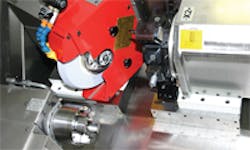Grind and turn for less part handling
The more processes shops can do on one machine tool the less automation is needed for part handling. When parts come off one machine complete, they don’t have to be transferred — either by automation or manually — to other machine tools.
One type of machine that allows for complete part machining is a grinder that also hardturns. Other benefits of such machines include improved part accuracy and reduced processing time.
For the Kleinhenz Co. in Friedrichsdorf, Germany, a job shop that specializes in turning operations, a grinder that does both grinding and hardturning helped reduce operating time nearly 50 percent.
The shop does sample production and prototype work for the automotive industry, and it serves the medical market, but its mainstay is tool making for the plastic-injection mold sector. It wanted a machine that would relieve job deadline pressures that were escalating in its hardturning department, and it aimed to accomplish that by machining parts completely on one machine. The shop saw that using one machine would eliminate the need for multiple machines and the material handling, tool and part set-up and other tasks that using multiple machines would entail.
“Hardturning has replaced many grinding operations in the last few years, thus reducing operating times. Nevertheless, hardturning cannot be reliably used to produce certain components, and additional grinding is necessary, as is re-clamping parts,” Harald Ernst, grinding and hardturing foreman at Kleinhenz, explained.
Kleinhenz purchased a Studer S242 modular hard fine machining center that Ernst said offers the technical specifications ideal for handling both grinding and hardturning operations. The technical specifications include stable toolholding fixtures, a large workhead spindle rpm range, and vibration-resistant workpiece clamping systems. In addition, an inclined machine bed allows chips from hardturning operations to fall away freely from the work zone and onto a scraper-chain conveyor.
The grinding capability of the Studer S242, available in North America through United Grinding Technologies, has not been compromised in favor of hardturning. High-performance grinding spindles are available, as are devices for balancing, dressing tools, in-process gauging, and adjusting fine cylindricity tolerance, and efficient coolant systems. Grinding sludge lands on a paper band filter that separates fine grinding chips from coolant.
As a modular machine, the Studer S242 is available as a short or long machine. In the short version, the distance between centers measures 400 mm. The distance between centers measures 1,000 mm for the long version.
The machine can be configured as a chucking machine or as a shaft machine with tailstock. Depending on the version, the Studer S242 can be equipped with two or three cross slides that can be used in a variety of ways – with a wheelhead for external grinding, with an internal grinding attachment or with a turret that has 12 tool positions.
Kleinhenz has the long-version Studer S242 with two slides, such as for an external grinding spindle and turret.
“This configuration is exactly what we needed because our typical workpieces for the machine are chucking components with cross bores and multi-edged surfaces, which require interrupted cut machining. Most of the parts are made of difficult-to-machine materials and have inner contours that are often conical or that have tangentially converging radii. Using grinding alone to manufacture such parts would be very expensive, so they have to be hardturned,” Ernst said.
By the time these components reach the Studer S242, they are pre-machined and expensive. Tolerances run under 5 microns, and Ernst said the machine handles these effortlessly.
To program for both grinding and hardturning, the Studer S242 packs a Fanuc CNC series 310i model A, along with Studer’s StuderWIN user interface. Self-explanatory pictograms make for easy programming of grinding operations, while Fanuc cycles and ISO programming are available for turning operations.
